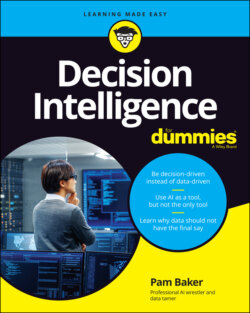Читать книгу Decision Intelligence For Dummies - Pamela Baker - Страница 44
Ushering in The Great Revival: Institutional knowledge and human expertise
ОглавлениеTwo of the biggest casualties in traditional data mining are institutional knowledge and human expertise. Institutional knowledge is defined as the knowledge within an organization about its own business and customers that’s passed on from older workers and leaders to newer ones in informal and usually verbal person-to-person exchanges. Because much of it is stored in the minds of workers and executives, it’s supremely difficult to identify, retrieve, and digitalize for inclusion in a data set. Therefore, it’s often lost when a person with some of this knowledge retires, dies, changes jobs, or otherwise stops being an active part of the company. Without this key information, business decisions can be made in the wrong context for the situation and result in failure or undesirable consequences.
Human expertise works similarly: It’s the knowledge gained by an individual by way of education, intuitive intelligence, talent, accumulated skill sets, experience, exposure, incidents of failure and success, encounters with anomalies and repetitious events, and a myriad of unique circumstances over the span of a career or lifetime. This information, too, is difficult to digitalize and add to a database. Therefore, human expertise also tends to be lost to illness, retirement, job change, or death.
The cost to any organization of the loss of either institutional knowledge or human expertise can be enormous in terms of money value, company culture, and the shape of the organization’s competitive edge. These facts are not lost to many in business leadership and data science, which is spurring a revival in both valuing and capturing these deep wells of specialized and irreplaceable data.
Some think of it as a great revival as the pendulum swings from one extreme to the other. For example, disinterest in customers from a focus on profits alone has now swung to a near-fanatical interest in personalizing every customer encounter and ensuring a great customer experience for each individual. This swing comes from a renewed appreciation for the value of human expertise (in this case in sales and marketing) and in institutional knowledge of customers and operations with regard to improving profits. In other words, once data-driven process efficiencies had mostly or completely been realized, companies learned that profits cannot be separated from customers, as the latter begats the former. Hence the resumed interest in reselling to existing customers and retaining customer knowledge beyond basic financial transaction details.
Though it’s reassuring to many to see human expertise added back into decision-making alongside data, it’s quite different to actually pull it off. Decision intelligence isn’t an easy exercise in its formation or execution.
After all, data sets are still huge. Even if you use and find value in only 10 percent of data, that’s still an awful lot of data to parse and analyze. AI is also faster than people at, well, everything. That’s an advantage that organizations want to maintain. Then there’s the need to automate tasks so that work gets done faster, more efficiently, and without the need to interrupt function, features, and the customer experience.
Where do all these factors come together in the decision intelligence effort? Well, that’s what you and your organization have to figure out for yourselves. Certainly, there are guidelines on how to do it as well as tools at your disposal that I present in greater detail later in this book. However, remember that the first part of bringing humans more fully into the decisioning roles is in deciding the particular blend of human versus machine processes that are needed.
Or, to put it another way — and in keeping with Kozyrkov’s earlier analogy — this is the part for the microwave chefs to work their magic in making the recipe. The job of the microwave builders is largely finished. You know you have the right recipe when you see the proof in the pudding, so to speak.
